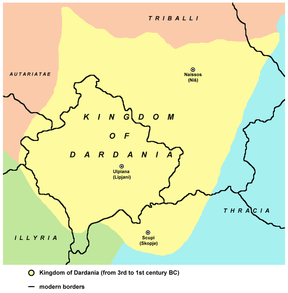Dardania
Dardania (/dɑrˈdeɪniə/; Ancient Greek: Δαρδανία; Latin: Dardania) was a Roman and Byzantine (Eastern Roman) province in the Balkans, initially an unofficial region in Moesia (87–284), then a province administratively part of the Diocese of Moesia (293–337). It was named after the ancient tribe of Dardani which inhabited the region prior to the Roman conquest (28 BC–6 AD).
Name
The etymology of the name Dardania has been associated with the Albanian word "dardha" meaning pear. [1] Bardyllis was a king of Dardania whose name in Albanian literally means "White-Star" from Bardh(White) and Yll(Star).[2] The region was inhabited by Illyrians, Celts[3][4] and Thracians.[4][5] After Roman conquest of Illyria at 168 BC, Romans colonized and founded several cities in the region.[6]
Present day location

The borders of Dardania have seen many administration divisions through out the ages while almost always occopying the same region. The region saw some continuity during the Ottoman period of the region under the Villayete of Kosovo while today it occupies the country of Kosovo, the ethnic Albanian regions of Serbia such as the Preshevo Valley in Serbia, Sanjac and the ethnic populated Albanian regions of the Republic of Macedonia
Roman Dardania
During the administrative reforms of Diocletian (244 - 311) and Constantine I (272 – 337), the Diocese of Moesia was created, encompassing most of the central Balkans and the Greek peninsula. After a few years, however, the diocese was split in two, forming the Diocese of Macedonia and the Diocese of Dacia, encompassing the provinces of Dacia Mediterranea, Moesia Inferior, Dardania, Praevalitana and Dacia Ripensis.
Since 238, Moesia was constantly invaded or raided by the Carpi, and the Goths, who had already invaded Moesia in 250. Hard pressed by the Huns, the Goths again crossed the Danube during the reign of Valens (376) and with his permission settled in Moesia.
Late Roman[7] Dardania did not include the eastern part of the Dardania of Aurelian
Since 238, Moesia was constantly invaded or raided by the Carpi, and the Goths, who had already invaded Moesia in 250. Hard pressed by the Huns, the Goths again crossed the Danube during the reign of Valens (376) and with his permission settled in Moesia.
Late Roman[7] Dardania did not include the eastern part of the Dardania of Aurelian
Byzantine period
The area remained part of the Byzantine empire until the late early 7th century when the Slavic migration destroyed Byzantine authority in most of the Balkan peninsula. Since then Dardania ceased to exist as separate administrative entity.
Cities
Dardania's largest towns by the time it was part of the Roman province of Moesia Superior were Ulpiana, Therranda, Vicianum, Skopi,[8] Vindenis, and Velanis. By this time Naissus[9] (a previously Celtic settlement) was the province's most important city.The Romans had organized a mining town municipium Dardanicum[10] (in modern Socanica near the Ibar valley) was connected with the workings (metalla Dardanica[10]). Dacians[11] lived in Dardania in their city Quemedava.
Also see
References
- Albanian Etymological Dictionary, V.Orel, Koninklijke Brill ,Leiden Boston Köln 1998, p.56
- http://www.argjiro.net/fjalor/index.php
- The central Balkan tribes in pre-Roman times: Triballi, Autariatae, Dardanians, Scordisci and Moesians by Fanula Papazoglu, ISBN 90-256-0793-4, page 265
- Pannonia and Upper Moesia: a history of the middle Danube provinces of the Roman Empire The Provinces of the Roman Empire Tome 4, ISBN 0710077149, 9780710077141, 1974, page 9
- Wilkes, J. J. The Illyrians, 1992, ISBN 0-631-19807-5, page 85, "Whether the Dardanians were an Illyrian or a Thracian people has been much debated and one view suggests that the area was originally populated with Thracians who where [sic?] then exposed to direct contact with illyrians over a long period..."
- Hauptstädte in Südosteuropa: Geschichte, Funktion, nationale Symbolkraft by Harald Heppner, page 134
- Starinar,Books 45-46,by Srpsko arheološko društvo,Arheološki institut (Belgrade, Serbia), page 33
- The Illyrians by J. J. Wilkes, 1992, ISBN 0-631-19807-5, page 49, "...historic Lychnitis around Ohrid and in Dardania around Skopje in the upper Vardar basin. Among the many tumuli surviving in Pelagonia only Visoi has so far been..."
- Naissos
- The Illyrians by J. J. Wilkes, 1992, ISBN 0-631-19807-5, page 258, "In the south the new city named municipium Dardanicum, was another 'mining town' connected with the local workings (Metalla Dardanica)."
- Ethnic continuity in the Carpatho-Danubian area by Elemér Illyés, 1988,ISBN 0-88033-146-1, page 223
- Annuario Pontificio 2013 (Libreria Editrice Vaticana, 2013, ISBN 978-88-209-9070-1), "Sedi titolari", pp. 819-1013
